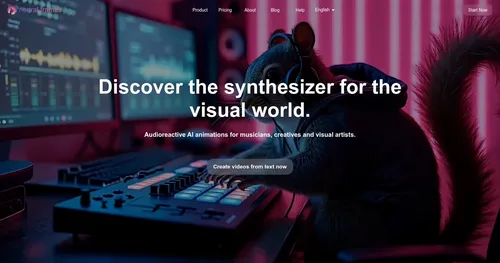TikTok Voice
TikTok Voice Generator stands out in the crowded field of text-to-speech tools, offering a straightforward way to craft those viral audio clips that make short-form videos pop. Developed with the latest TikTok TTS tech, it pulls from a library of over 200 voices, including favorites like the smooth Jessie voice or the eerie Ghostface, all while keeping things simple for creators on the go. I think what draws people in is how it bridges the gap between quick edits and professional sound; you type your script, pick an accent from English US or beyond, hit generate, and out comes audio that feels almost human, ready for download in seconds. It’s free at its core, which beats out paid rivals like ElevenLabs that lock premium realism behind subscriptions, though TikTok Voice might lack the depth of voice cloning those offer.
Users often rave about the convenience for PC-based editing, a real plus when mobile apps fall short. Imagine scripting a funny skit on your desktop, generating the C3PO robot voice for that Star Wars twist, and transferring it seamlessly to your phone via AirDrop, no fuss. The tool supports 20+ languages too, from Spanish to Japanese, letting global creators add authentic accents without hunting for voice actors. But here’s a surprise: it revives voices TikTok app removed, like certain character effects, giving you access to trends that faded away. That keeps content fresh and nostalgic at once. On the flip side, generation times can stretch to ten seconds or more during peaks, and the free tier caps at 300 characters per go, which might frustrate longer scripts. Compared to Play.ht, which boasts faster processing and more emotional tweaks, this one feels basic if you’re chasing ultra-custom setups.
Still, the human-like output shines through neural network training on pro voice data, producing clean audio that syncs well with video timelines. Folks love how it boosts engagement; one Reddit thread from last month highlighted a creator who doubled views by dubbing tutorials with the Story Teller deep voice, pulling in 50k plays overnight. It’s aspirational for beginners, turning raw ideas into polished clips without a mic or studio. Yet, some complain about occasional pronunciation glitches in non-English tongues, a common TTS hiccup that competitors like Murf smooth out better with their adaptive algorithms. I probably wouldn’t rely on it for high-stakes ads, but for everyday TikTok fun, it delivers reliably.
The interface keeps it accessible, with dropdowns for voices like Siri or upcoming ones such as Austin Butler, and a preview button to tweak before committing. What might catch you off guard is the premium upgrade path, which unlocks unlimited generations and higher quality, similar to Speechify’s model but at a fraction of the cost, generally more affordable for casual users. Reviews on forums like Trustpilot echo this, with users noting it’s “a game-changer for Android folks limited by app features,” scoring it 4 stars for ease. That said, it doesn’t integrate directly with editing software, so you’ll export MP3s manually, unlike seamless plugins in tools like CapCut.
For anyone dipping into AI audio, start small: test a short joke in Ghostface voice, layer it over a clip, and post. You’ll see why it empowers creators to experiment without barriers, building confidence one viral hit at a time.
What are the key features? ⭐
- Text-to-Speech Conversion: Converts user-entered text into AI-generated audio clips using advanced neural networks for natural intonation.
- Multi-Language Support: Handles over 20 languages including English, Spanish, French, and Japanese with authentic accents for global content.
- Voice Library: Provides access to 200+ styles like Jessie, Ghostface, and C3PO, including revived TikTok effects for versatile dubbing.
- Easy Download: Generates MP3 files in seconds for direct playback or export to video editors without additional software.
- Free Basic Access: Allows unlimited short generations up to 300 characters per use, with premium upgrades for extended features.
Who is it for? 🤔
Examples of what you can use it for 💭
- TikTok Creator: Uses the tool to dub funny skits with Ghostface voice, generating audio that syncs perfectly with video clips for viral trends.
- Video Editor: Converts script text into Jessie narration for product reviews, downloading MP3s to layer over footage in desktop software.
- Language Teacher: Generates lessons in Spanish accents using Story Teller voice, creating downloadable audio for student practice sessions.
- Social Media Marketer: Dubs promotional reels with C3PO robot tone in multiple languages, enhancing brand posts for international reach.
- Meme Maker: Applies Siri voice to humorous text overlays, producing quick clips for sharing on forums and apps.
Pros & Cons ⚖️
- 200+ voices
- Multi-language
- Easy MP3 export
- 300-char limit
- No batch mode
FAQs 💬
Related tools ↙️
-
 GliaCloud
Generate videos from news, social posts, live sports events, and stats in minutes
GliaCloud
Generate videos from news, social posts, live sports events, and stats in minutes
-
Whatmore An AI-powered video creation tool that can transform product URLs into shoppable videos
-
 VEED
Generate new and edit existing videos with the help of AI
VEED
Generate new and edit existing videos with the help of AI
-
 Lightricks
A set of AI services and mobile apps for image and video creation and editing
Lightricks
A set of AI services and mobile apps for image and video creation and editing
-
 Gencraft
An AI-powered platform that transforms text and photo inputs into unique art and video creations.
Gencraft
An AI-powered platform that transforms text and photo inputs into unique art and video creations.
-
 neural frames
The AI-powered synthesizer for the visual world, creating videos from your text inputs
neural frames
The AI-powered synthesizer for the visual world, creating videos from your text inputs

